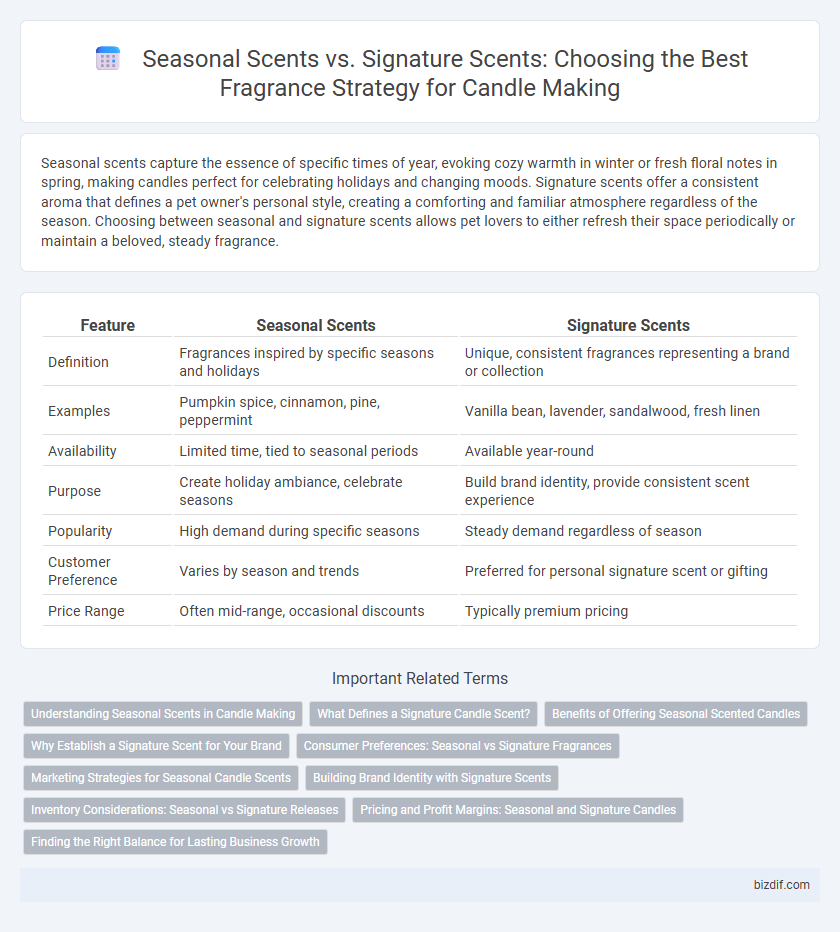Seasonal scents capture the essence of specific times of year, evoking cozy warmth in winter or fresh floral notes in spring, making candles perfect for celebrating holidays and changing moods. Signature scents offer a consistent aroma that defines a pet owner's personal style, creating a comforting and familiar atmosphere regardless of the season. Choosing between seasonal and signature scents allows pet lovers to either refresh their space periodically or maintain a beloved, steady fragrance.
Table of Comparison
| Feature | Seasonal Scents | Signature Scents |
|---|---|---|
| Definition | Fragrances inspired by specific seasons and holidays | Unique, consistent fragrances representing a brand or collection |
| Examples | Pumpkin spice, cinnamon, pine, peppermint | Vanilla bean, lavender, sandalwood, fresh linen |
| Availability | Limited time, tied to seasonal periods | Available year-round |
| Purpose | Create holiday ambiance, celebrate seasons | Build brand identity, provide consistent scent experience |
| Popularity | High demand during specific seasons | Steady demand regardless of season |
| Customer Preference | Varies by season and trends | Preferred for personal signature scent or gifting |
| Price Range | Often mid-range, occasional discounts | Typically premium pricing |
Understanding Seasonal Scents in Candle Making
Seasonal scents in candle making capture the unique aromas associated with specific times of the year, such as pumpkin spice in autumn or pine and cinnamon during winter holidays. These fragrances evoke emotional connections and nostalgia by aligning with seasonal experiences and festivities, enhancing the ambiance of a space. Unlike signature scents that provide a consistent brand identity, seasonal scents enable candle makers to diversify product offerings and attract customers seeking timely, mood-driven aromas.
What Defines a Signature Candle Scent?
A signature candle scent is defined by its unique and consistent fragrance profile that embodies a brand's identity, creating a lasting emotional connection with customers. Unlike seasonal scents that change with trends and holidays, signature scents are carefully crafted to maintain a recognizable aroma year-round, often blending specific essential oils and aromatic compounds to evoke particular moods or memories. This distinct olfactory identity not only differentiates a candle maker in a competitive market but also fosters brand loyalty through a memorable sensory experience.
Benefits of Offering Seasonal Scented Candles
Offering seasonal scented candles enhances customer engagement by providing fragrances that evoke specific holidays or times of year, boosting emotional connections with the brand. Seasonal scents encourage repeat purchases as consumers seek to refresh their ambiance in line with changing seasons, increasing sales frequency. This strategy also allows candle makers to showcase creativity and variety, catering to diverse preferences while maintaining signature scents as a stable product base.
Why Establish a Signature Scent for Your Brand
Establishing a signature scent for your candle brand creates a unique and memorable identity that distinguishes your products in a competitive market. Unlike seasonal scents that fluctuate with trends and holidays, a signature scent builds consistent brand recognition and fosters customer loyalty year-round. This consistent aroma becomes synonymous with your brand, turning buyers into repeat customers who associate the fragrance with quality and trust.
Consumer Preferences: Seasonal vs Signature Fragrances
Consumer preferences in candle making often vary between seasonal scents and signature fragrances, with many buyers gravitating toward seasonal options that evoke specific holidays or times of the year like cinnamon for fall or pine for winter. Signature scents appeal to those seeking a consistent, recognizable aroma that defines their personal or home ambiance year-round, such as lavender or vanilla. Market trends indicate a rising demand for limited-edition seasonal candles, yet a loyal base remains dedicated to classic signature fragrances for everyday use.
Marketing Strategies for Seasonal Candle Scents
Seasonal candle scents capitalize on timely aromas like pumpkin spice, pine, or cinnamon, driving urgency and increasing sales during specific holidays or seasons. Marketing strategies for seasonal scents include limited-time offers, targeted social media campaigns, and collaborations with influencers to evoke emotional connections tied to festive occasions. Emphasizing exclusivity and seasonal ambiance boosts customer engagement and encourages repeat purchases around niche periods.
Building Brand Identity with Signature Scents
Signature scents establish a consistent olfactory identity that reinforces brand recognition and loyalty in the candle market. Unlike seasonal scents that change periodically, signature scents create a lasting emotional connection and differentiate the brand from competitors. Investing in a unique, memorable fragrance enhances marketing efforts and cultivates a dedicated customer base.
Inventory Considerations: Seasonal vs Signature Releases
Seasonal scents require careful inventory management due to their limited-time offerings and fluctuating demand, often necessitating smaller, more frequent batches to avoid surplus stock. Signature scents benefit from consistent production and steady inventory turnover, providing reliable sales and reducing the risk of overstock. Balancing seasonal variety with staple signature fragrances optimizes inventory levels and maximizes profitability in candle making businesses.
Pricing and Profit Margins: Seasonal and Signature Candles
Seasonal candle scents typically carry higher production costs due to limited ingredient availability and packaging tailored to holidays, resulting in variable profit margins. Signature scents benefit from consistent, bulk ingredient purchasing, lowering costs and ensuring stable pricing strategies that maximize long-term profitability. Pricing for seasonal candles often allows premium markups driven by demand spikes during specific times, while signature candles rely on steady sales volumes to optimize profit margins.
Finding the Right Balance for Lasting Business Growth
Seasonal scents like pumpkin spice and pine evoke timely emotions, boosting sales during specific holidays, while signature scents create brand identity with consistent fragrance profiles. Balancing limited-edition seasonal aromas and timeless signature scents maximizes customer engagement and fosters long-term loyalty. Incorporating data on purchasing patterns and scent preferences enables candle makers to optimize inventory, marketing strategies, and product offerings for sustainable business growth.
Seasonal scents vs Signature scents Infographic

 bizdif.com
bizdif.com